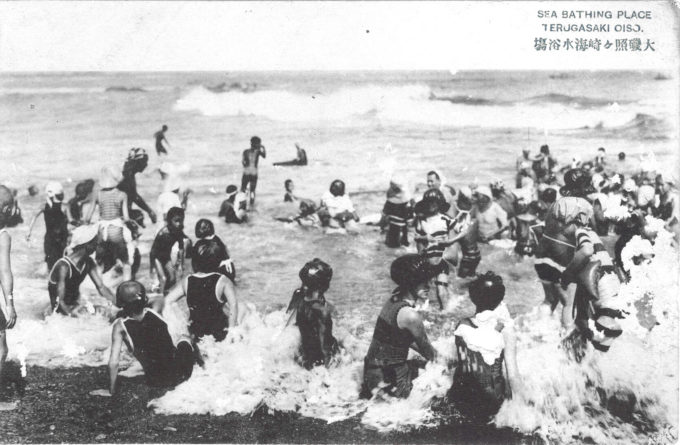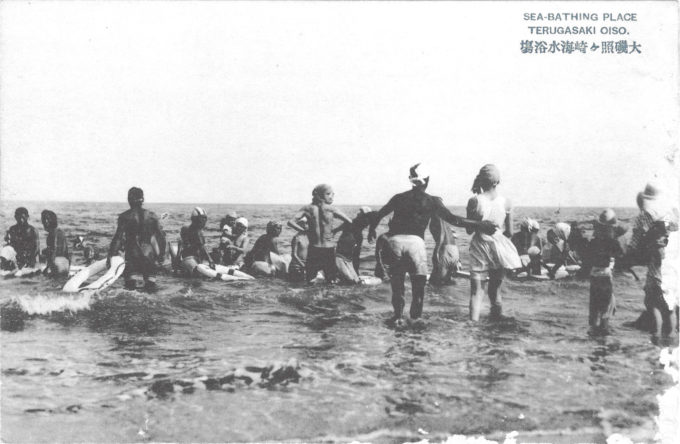“Oiso, though a sufficiently flourishing town in the days when Kamakura was the military capital of Japan, now attracts attention solely for the beauty of its sea-scape and the excellence of its surf bathing.
“Before the renewal of intercourse with the Western world, the idea of private villas by the sea-side or in the mountains was practically unknown to the Japanese. When excessive heat in the low lands, or hygienic considerations, suggested a change of air, all that could afford the luxury repaired to one of the celebrated spas in the hills, where excellent inns afforded ample accommodation, and the visitors lived a kind of family life, free from all restraint except the dictates of courtesy.
“But among the nation’s many adoptions of Western customs none has been more conspicuous of late years than a constantly growing tendency for the merchant, who formerly had no thought of domestic life beyond his business precincts, to build himself a suburban residence on the hills invariably found in the environs of a Japanese city, and for the nobleman or man of affluence to seek a pleasant site in the mountains or by the sea-side, and to erect there a besso [‘country villa’, or ‘second home’] with due accompaniment of garden and rockery.
“Oiso, Koiso, Odawara, Kamakura, Zushi, Enoshima, Kanazawa, Tomioka, and other lovely little nooks along the shores of Sagami and the Izu promontory bear witness to this new taste, nor can there be any doubt that in the near future, when the whole of Japan is thrown open to foreign trade, travel and residence, many Europeans and Americans will learn to appreciate the advantages of seeking resorts in a country where not only scenic loveliness, a delicious climate and perfectly courteous neighbours are to be found, but where also a fortune insignificant in the West procures for its possessor comforts and consideration altogether out of traditional proportion to their cost.
“Tourists desirous of forecasting this phase of Japan’s future, as well as of witnessing a succession of sea-scapes not equalled in many parts of the world, may spend a pleasant, wholesome and interesting time wandering from one to another of the places mentioned here.”
– Handbook of Information for Passengers and Shippers, published by Nippon Yusen Kaisha (NYK), 1896
“The Shonan coast in Kanagawa attracts day trippers for its many charming offerings such as beaches, temples and shrines, gardens and fresh seafood. Along this coast is Oiso, a beautiful seaside destination that offers all of that, but happens to be less crowded than famous spots like Kamakura and Enoshima.
“In fact, the first beach to open in Japan was in Oiso. In 1885, Army Medical Chief Baron Jun Matsumoto recommended sea bathing as a form of advanced medical treatment and decided to open Oiso beach. As a result, in 1887, Oiso Station [on the Tokaido Main Line] was opened.
“After that, many political, business and culture moguls either bought or inherited villas in the area. This included former prime ministers Aritomo Yamagata, Hirobumi Ito, Takashi Hara, Shigenobu Okuma, Kinmochi Saionji, Takaaki Kato, Masatake Terauchi and Shigeru Yoshida as well as former Foreign Minister Munemitsu Mutsu. Oiso became known as the ‘Meiji Okuzashiki’, meaning a place where one can spend time quietly away from the city’s hustle.”
– “An Undisturbed Seaside Getaway in Oiso”, by Alma Reyes, Tokyo Weekender, February 17, 2022
“Ōiso is the ancient centre of Sagami Province. The exact location of the Nara period provincial government of Sagami Province is unknown, but tradition and the place name ‘Kōzu’ place its probable location within the boundaries of present-day Ōiso.
“As a minor coastal settlement, Ōiso was under the control of the later Hōjō clan of Odawara during the Sengoku period. In the Edo period, it was nominally part of Odawara Domain, and developed as Ōiso-juku, a post town on the Tōkaidō connecting Edo with Kyoto. After the Meiji Restoration and with the establishment of the district system in 1878, it came under the control of Yurugi District (淘綾郡, Yurugi-gun).
“Ōiso became a town on 1 April 1889 with the creation of the modern municipalities system. Blessed with a temperate climate, and with convenient access to Tokyo due to the Tōkaidō Main Line railway, it was favoured as a seaside health resort by politicians and literary figures during the Meiji period after a glowing report on its location was written by noted physician Matsumoto Jun. Prime Minister Itō Hirobumi, Yamagata Aritomo, Saionji Kinmochi and Ōkuma Shigenobu, Foreign Minister Mutsu Munemitsu, writer Shimazaki Toson and zaibatsu founder Yasuda Zenjirō had summer residences in Ōiso.”
– Wikepdia



